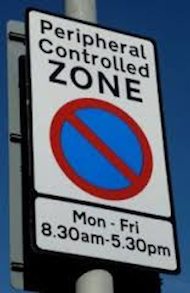Peripheral control nerdview
« previous post | next post »
In various areas of Edinburgh there are signs that say "Peripheral Controlled Zone." What exactly would you do if you encountered one of these signs? What would it mean to you? Not much? That's the hallmark of nerdview.
What is peripheral to what? Who is controlling what? What is peripheral control? Why are you being told this? Nothing becomes clearer as you mull over what it says. They might as well have put up a sign saying "Argle bargle nurff gugga mongmong gooboo wah Mon – Fri 8:30am – 5:30pm."
But worse, if you did know what it meant you would become aware that it could not possibly be relevant to you.
For the traffic and parking control staff who work in the relevant department of the Edinburgh City Council, it is clear enough. Having instituted a system of parking control by marked spaces, residents' permits, pay-and-display areas, and solar-powered parking permission slip vending machines, they later realized that (because they had unintentionally turned all the streets just outside to the city center into commuter parking lots) they had to extend it to adjacent outlying areas, with a lower parking permit price. For parking management purposes, they therefore came to be managing a central controlled zone and a peripheral controlled zone.
But (the crucial point) you don't need to know that. Nor do I. Nor does any driver in the city.
The phrase "peripheral controlled zone" belongs to management terminology and should be entirely limited to management circles. All that laypeople in cars need to know is whether they can park. The "residents only" spaces are already marked on the roadway in white paint, and that's enough. Drivers looking for a place to park have no interest in knowing who pays the higher price for their resident's parking permit and who pays the lower peripheral-zone price. They just need to know which spaces are free, which are pay-and-display, and which are restricted to residents.
Putting up signs saying "peripheral controlled zone" is a perfect example of what Language Log calls nerdview.
